Main content starts here.
Welcome to Yamanashi, the Home of Mt. Fuji
Welcome to Yamanashi ! We are delighted to welcome everyone from around the world. Everyone’s plans and reasons for traveling may be different, but one common benefit of traveling that anyone can enjoy is learning up close about the ways of thinking, customs, and culture of the people living in the area. We would like you to read about the following customs and rules in Japan to help you understand more about the country, feel closer to the Japanese people, and have an enjoyable and unforgettable experience while you are here. We anxiously await your visit!
Manners Video
THE RESPONSIBLE TRAVELER produced by Japan Tourism Agency 
TAKING PICTURES #1
ENGLISH CHINESE(simplified) CHINESE(traditional) KOREAN
TAKING PICTURES #2
ENGLISH CHINESE(simplified) CHINESE(traditional) KOREAN
WALKING ON THE STREETS
ENGLISH CHINESE(simplified) CHINESE(traditional) KOREAN
PUBRIC TRANSPORTATION
ENGLISH CHINESE(simplified) CHINESE(traditional) KOREAN
TRADITIONAL BUILDINGS
ENGLISH CHINESE(simplified) CHINESE(traditional) KOREAN
PUBLIC BATHS AND HO電話番号S
ENGLISH CHINESE(simplified) CHINESE(traditional) KOREAN
RESTAURANTS #1
ENGLISH CHINESE(simplified) CHINESE(traditional) KOREAN
RESTAURANTS #2
ENGLISH CHINESE(simplified) CHINESE(traditional) KOREAN
PUBLIC SPACES #1
ENGLISH CHINESE(simplified) CHINESE(traditional) KOREAN
PUBLIC SPACES #2
ENGLISH CHINESE(simplified) CHINESE(traditional) KOREAN
Manners for Public Places
The people of Japan have traditionally placed great emphasis on cooperation, being mindful of their behavior and those around them while in public. Refraining from speaking in loud voices and talking on phones in places like restaurants, stores, trains, buses, and other public spaces is deeply rooted in Japanese culture. As such, please be mindful of the following points to behave appropria電話番号y in public spaces: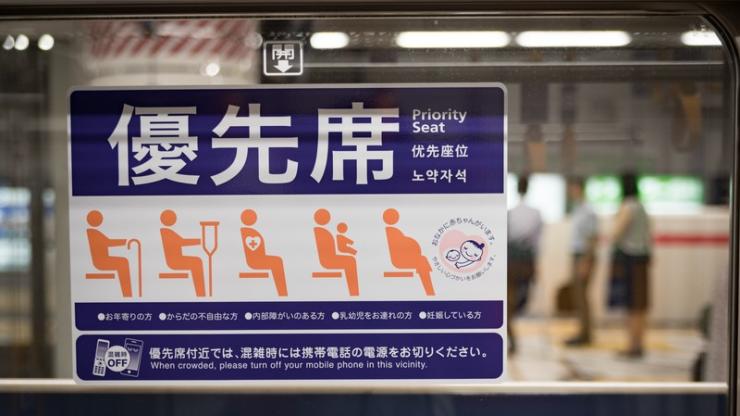
- Be mindful of others and talk quietly in public spaces.
- Refrain from talking on the phone on public transportation such as trains and buses, setting your phone to silent mode and only using it in emergencies.
- When crowded, please turn off your phones in the vicinity of priority seats on trains. *Heart pacemakers and other medical devices may be set off
Waiting your turn
Lining up and waiting your turn is a practice deeply ingrained in Japan, with almost everyone following this rule. At a bank ATM or in the restroom, people form a single line and wait until one becomes available.
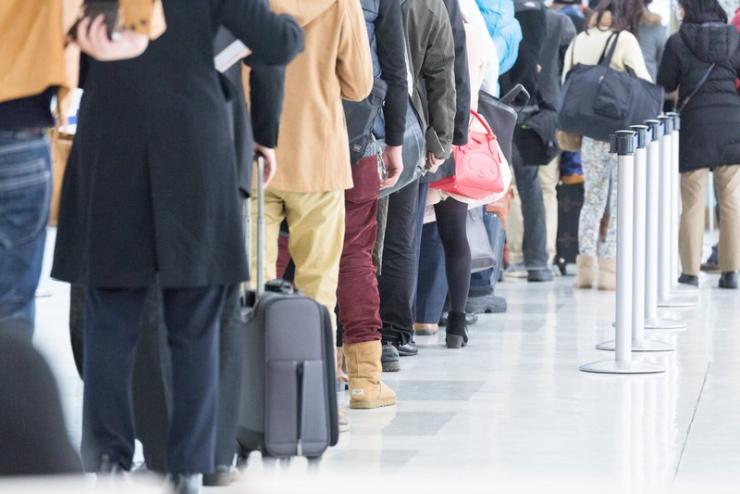
Please stand in line and wait your turn. Cutting to open spaces is an etiquette violation. In order to avoid unnecessary trouble, please obey this social custom and wait your turn.
Smoke only in designated places
For both indoor and outdoor public spaces, smoking is not allowed other than in designated smoking zones. Depending on the establishment, smoking while walking or smoking in the vicinity of a building may be prohibited, sometimes incurring fines.
- Please use smoking areas when in public places.
- In crowded places, smoking while walking may harm other people if lit cigarettes come into contact with other people’s skin or personal belongings. Please do not smoke while walking.
Restrooms
In Japan, there are two types of toilets, western-style seated toilets, and Japanese-style squat toilets. Western-style toilets in Japan are often equiped with washlet technology, and there are also toilets with special sound effects like the running water of a stream or birds chirping. If you have accidentally dirtied the toilet, please be considerate of the next person and clean it. The toilet paper provided will dissolve in water. When you are done using it, please dispose of it properly by flushing it down the toilet.Follow the instructions below for correct use of each type of toilet.
Western-style toilets
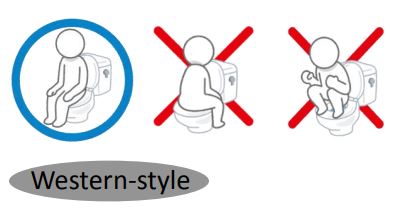
1. Open the lid. Put the u-shaped seat down. 2. Sit with the lid upright behind you. Step one leg over and squat. 3. When you are done, wipe yourself with the provided toilet paper, then dispose the paper in the toilet. 4. Use the lever or button to flush the water down
Japanese-style squat toilet
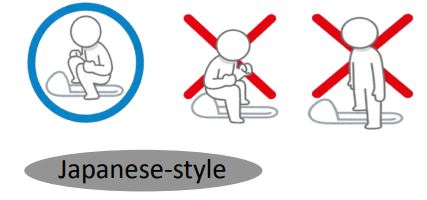
1. Ensure that the round end jutting out is facing your front. Step one leg over and squat.2. When you are done, wipe yourself with toilet paper, then dispose of the paper in the toilet. 3. Use the lever or button to flush the water down.
Hot Springs (Onsen) and Public Baths (Sento)
In Japan there are hot springs called onsen and public bathing facilities called sento, places where you can interact and socialize with other people. In this social setting, people naturally came to an unspoken understanding regarding bathing etiquette so that everyone could comfortably bathe.
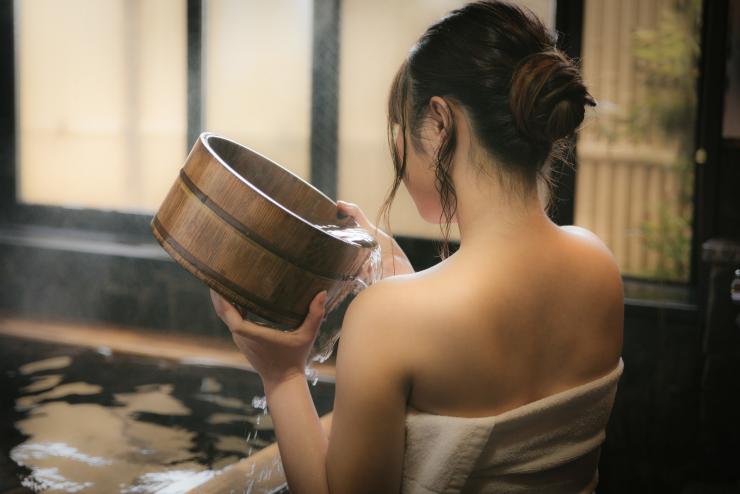
Hot springs (onsen) are very pupular in Japan due to its health benefits, and you can find onsen in many traditional inns, ryokan. The same bathing etiquette applies to both sento and onsen. Please enjoy Japan’s unique “naked bonding” culture at onsen and other public bathing facilities.
- Please share the changing room, shower room, and baths with others.
- When heading to the bathing room, take no clothing with you (including underwear) except for a small face towel. You may also bring shampoo and soap. Entering the bathing room while wearing swimwear or bathrobes is an etiquette violation.
- Before entering the baths, please wash your body in the washing area. Plunging into the water without washing yourself first is not allowed.
- The baths are for heating up your body. Swimming is not allowed.
- Washing your body in the baths is an etiquette violation.
- Be sure to wipe your body dry when returning to the changing room from the bathing room. If you enter the changing room while wet, you may drip on the floor and make it slippery and unsafe for others.
- Many onsen and other public bathing facilities may turn away visitors with tattoo.
Japanese Ryokan Inns
As traditional Japanese-style accommodations, ryokan exude a uniquely Japanese atmosphere. However, there are a number of etiquette rules to follow.
Because Japan is very rainy and humid, in order to maintain a clean and hygenic home, Japanese people do not enter houses with their shoes on. Instead, they remove their shoes in the entranceway, and sit directly on the floor or tatami mat or lay down a futon.

- In the entranceways at ryokan, the room’s floor is raised slightly above the outside level, indicating where it is not ok to wear shoes. There will also be slippers left near this area for you to wear. Even though you are wearing slippers instead of shoes, you must still remove your slippers when entering the tatami room.
- In the tatami room, please be careful with your luggage as the tatami floor is easily damaged.
- Please cooperate in keeping the building clean. Throw trash into the garbage containers and do not spit indoors.
- Amenities and equipment, as bath towels, keys, hair dryers, and tea sets must remain within the building. Please do not take them with you when you leave.
Japanese Table Manners

In Yamanashi local specialties as houtou and torimotsu are the most famous dishes.To help you to enjoy Yamanashi's delicious food to the most, here are some tips to Japanese dinning etiquette.
Restaurants
Many restaurants have low tables and tatami floor. You will be requested to take off your shoes before stepping on the tatami and to seat in cushions called zabuton.
Before eating
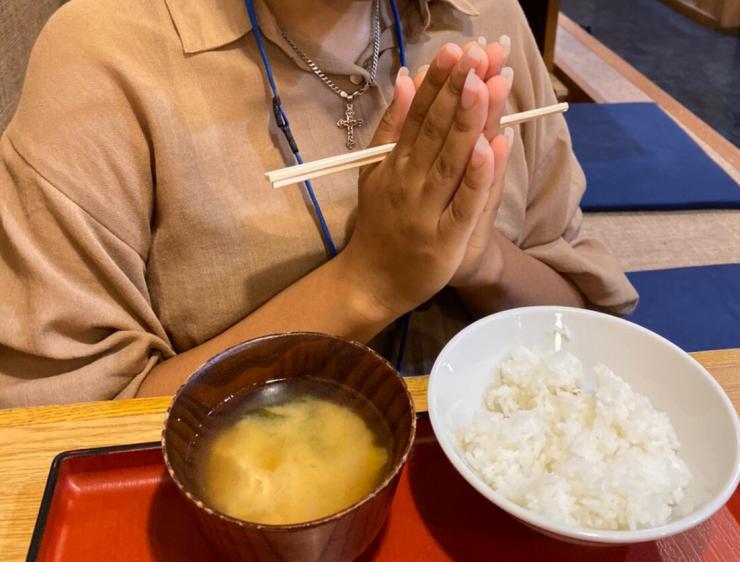
In many places, you will receive an oshibori, a wet towel to clean your hands.
When eating with many people, it is common to wait to everyone's order arrive to start eating and before taking the first bite Japanese people say "Itadakimasu", usually translated as "I am glad to receive this food" (after finishing, "Gochisosama desu", meaning "thank you for the food" is the phrase you might hear).
Eating
If you are eating from shared dishes, use the chopsticks placed in the dish especially for picking the food and placing it in your own plate, when it is available.
Eating the food to the last grain of rice is considered good manners, and taking leftovers home is not possible in most restaurants. If you have any dietary restrictions due to allergies or religious reasons, it is advised to check beforehand which ingredients are used for the dish and if any item in your order can be replaced.

When eating:
- Rice: hold the rice bowl with one hand and chopsticks with the other. Leaving the rice bowl on the table while eating is considered bad manner.
- Miso soup: drink the miso soup directly from the bowl, as if it is a cup. There is no spoon for drinking it.
- Sushi: You can eat sushi either with your hands or using chopsticks. As a general rule, the sushi rice should not be dipped in the soy sauce, only the fish topping.
- Noodles: many Japanese will slurp the noodles when eating noodles, as udon, soba or our local specialty, houtou. It is a common practice, but do not fell pressured to do the same.
Home of Mt. Fuji > About Yamanashi > Japanese Manners and Customs

